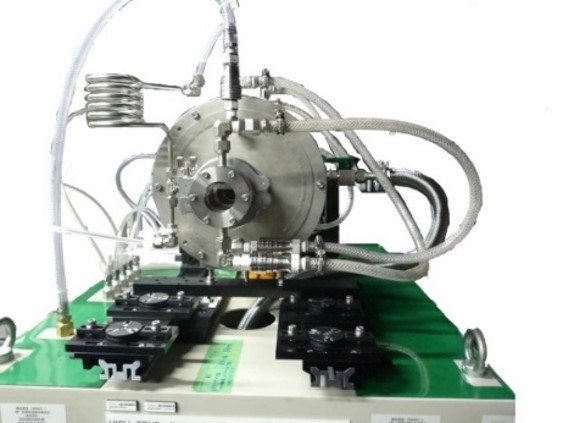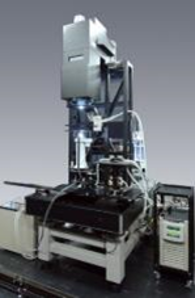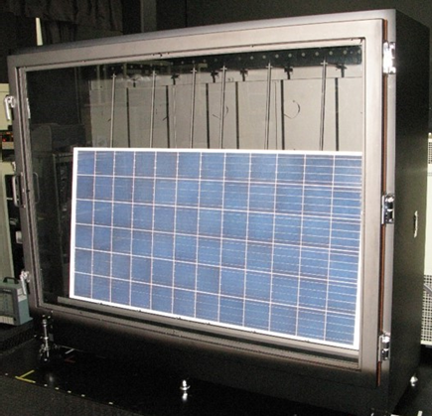Advanced Performance Characterization Technology for Photovoltaic Cells & Modules and Calibration Technology on Reference Photovoltaic Devices
Overview
In the efforts to utilize renewable energy as the major power source, the efforts for making the solar power as a self-reliant long-term stable power source have been made. As part of these efforts, research and development of various types of high-efficiency photovoltaic (PV) devices with novel structures and/or materials has been conducted, aiming to open up new PV markets, along with expanding the conventional mass introduction such as PV power plants and rooftop installations.
Research Target
The team is engaged in research and development of calibration and performance measurement technologies for PV devices (cells and modules), contributing to the improvement of international competitiveness of Japanese PV industries and the mass introduction of PV systems in Japan.
The research targets are;
- Improvement of calibration capability of reference PV devices (Tsukuba Center)
- Precise and reliable performance measurement technologies for novel PV cells and modules (Tsukuba Center)
- Outdoor performance measurement technologies for PV modules (Tsukuba Center)
- Outdoor characterization technologies of both energy yield and long-term reliability for various PV modules (Kyushu Center)
In addition, as an ISO / IEC 17025 accreditation laboratory (IAJapan ASNITE 0021 Calibration) according to international mutual recognition arrangements (MRA) for ILAC and APAC, the team is conducting the primary calibration service of reference PV cell as the AIST request test.
Research Outline
We develop precise calibration and performance measurement technologies of PV devices, which directly contribute to the value of PV, and confirm and establish the international conformity of these technologies through the proficiency tests and international comparison measurements. We also supply reference PV cell calibration to the PV community and measure a wide variety of PV devices from PV manufacturers. The measurement and calibration technologies developed in the research activities are actively disseminated through standardization such as JIS and IEC.
Main research activities are the followings;
Development and improvement of the calibration technology of reference PV devices:
We are conducting research related to the development and improvement of calibration technology of reference PV devices used for accurately measuring the irradiance of natural sunlight and solar simulator. We have contributed from the beginning as one of the four qualified calibration laboratories worldwide to maintain World Photovoltaic Scale (WPVS) which is the key comparison reference value of the primary calibration of reference PV cell. We also provide reference values for proficiency test and inter-laboratory comparison conducted according to the requirements of ISO / IEC 17043, and are cooperating in performance evaluation and accreditation acquisition activities of domestic and overseas calibration laboratories and institutions.
Development of precise and reliable performance measurement technology for newly developed PV devices:
We are conducting research and development of the precise performance measurement technologies of PV devices under the Standard Test Conditions (STC) (spectral irradiance of AM1.5G, total irradiance of 1 kW/m2, cell-junction temperature of 25 degrees Celsius) as well as other conditions such as varying spectrum, irradiance, and device temperature. We also perform current-voltage (IV) characteristic measurements of the state-of-the-art PV devices (crystalline silicon, CIGS, perovskite, multi-junction, concentrator PV modules, etc.) developed in PV industries and research institutes. To confirm the technological conformity of the PV performance measurement technologies, proficiency tests and inter-comparison measurements among international research institutes and/or testing laboratories are regularly performed.
Development of precise outdoor performance measurement technologies for PV modules:
Due to wide spreading of PV systems, outdoor performance characterization and monitoring technologies available and useful for the system operations & maintenance (O&M), become increasingly important. In the team, fast and precise outdoor measurement technologies including IV correction methods, which meet a demand from the PV community, are investigated.
Development of characterization technology of energy yield for novel PV modules exposed outdoors:
Various types of PV modules of about 70 kW (about 100 kW in future) including not only commercial PV modules but also newly developed test modules are exposed outdoors in Kyushu Center. The IV characteristics of the PV modules set in the outdoor site are recorded every 10 min and are analyzed with the measured irradiance and module temperature in order to evaluate the energy yield of PV modules, especially novel-type thin-film PV modules, in the long-term. In addition, high-efficiency PV modules (PERC silicon modules etc.) have also been exposed outdoors since 2016.
Main Research Facilities
Instruments related to reference-cell calibration technologies


 Ultrahigh-temperature fixed-point blackbody furnace (left); Highly collimated solar simulator (center); High-speed spectroradiometer with extremely small nonlinearity error (right).
Ultrahigh-temperature fixed-point blackbody furnace (left); Highly collimated solar simulator (center); High-speed spectroradiometer with extremely small nonlinearity error (right).
Instruments used for performance characterization of PV devices


 Solar simulator (left) and Temperature chamber (center) used for PV modules.
Solar simulator (left) and Temperature chamber (center) used for PV modules.
Facilities for outdoor performance characterization of PV modules (right)
Outdoor exposure site for PV modules
 Panoramic view of PV modules at outdoor exposure site of AIST Kyushu Center (Tosu City, Saga Prefecture).
Panoramic view of PV modules at outdoor exposure site of AIST Kyushu Center (Tosu City, Saga Prefecture).
Activities and Achievements
- Regarding the primary calibration technology, the calibration capability uncertainty has been improved from 0.72% (present accredited value) to 0.60%. The validity of the estimated calibration value and its uncertainty is verified by the inter-comparison measurements among the qualified laboratories constituting WPVS.
- We have developed the precise and reliable performance measurement procedure based on the IV measurement and the maximum-power point tracking (MPPT) method for perovskite PV devices.
- Outdoor high-speed IV measurement technology using PV module irradiance sensors (PVMS) was developed. Reproducibility of Pmax measurement was drastically improved within ±1 % in a wide range of solar irradiance (0.3 - 1.0 kW/m2) for not only conventional-type crystalline-silicon modules but also silicon-heterojunction and CIGS thin film modules, in comparison with that of around ±5 % in the conventional technology using pyranometers.
- We have developed methods of estimating the power generation amount with the accuracy of ± 2 % for both conventional crystalline-silicon and silicon-heterojunction PV modules exposed outdoors with considering their annual degradation rates.
Team Member
| Title |
Name |
| Leader |
YOSHITA Masahiro |
| Chief Senior Researcher |
TAYAGAKI Takeshi |
| Senior Researcher |
IGARI Sanekazu |
| Senior Researcher |
CHIBA Yasuo |
| Researcher |
KOJIMA Takuto |
| - |
HARA Koujirou |